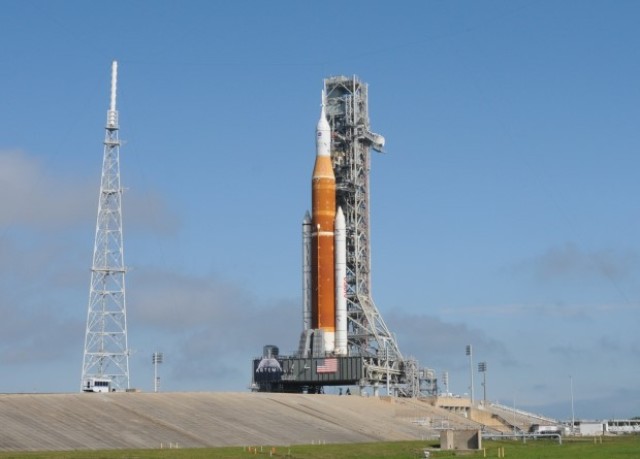NASA rolled out for the first time to the launch pad of the Cape Canaveral cosmodrome, a superheavy SLS rocket that will send astronauts on lunar missions. It is expected that the first flight of the rocket will take place in the summer of 2022.
SLS is a promising superheavy rocket that NASA plans to use for launches beyond near-Earth orbit. It has two stages and two side boosters. The initial version, which was rolled out by NASA, will be able to lift up to 90 tons of cargo, and in the future the load capacity will be increased twice: first to 105 tons, and then to 130. The SLS project uses a lot of developments from the Space Shuttle program and the unrealized Ares V rocket, which SLS is designed to replace. The first stage uses four RS-25 engines developed for "Shuttles", and the side solid-fuel boosters are based on the accelerators of these spaceplanes, you can read more about this in our text "On solid traction."
Despite the borrowing of developments, the project turned out to be much more expensive than planned, and the first launch, which was originally scheduled for 2016, was repeatedly postponed. Recently, NASA Inspector Paul Martin announced that the cost of one Orion launch on the SLS is $ 4.1 billion. 2.2 of them fall on the rocket itself, another 0.57 on the necessary ground expenses, and the rest is the cost of the American and European parts of the Orion spacecraft. Last year, NASA decided to replace the rocket for launching an interplanetary mission to Europe from SLS to Falcon Heavy, the cost of the new launch contract was $ 178 million.
In October 2021, NASA for the first time fully assembled the SLS together with the Orion spacecraft designed for lunar missions. Subsequently, the agency's engineers tested the rocket for several months, and after successful tests, it was sent to the launch pad of the Kennedy Space Center to begin preparations for the first launch. The rocket and the maintenance tower were transported on a self-propelled tracked conveyor for more than 10 hours, the distance between the assembly shop and the launch site is 6.5 kilometers.
In the first half of April, the SLS will be refueled to test the operation of all parts of the rocket's fuel system and ground infrastructure. Then the fuel will be poured off, and the rocket will be returned to the assembly shop to install the pyropatrons and conduct final preparations before the launch, which will take place no earlier than June. During the first flight, the rocket will send the Orion spacecraft without a crew on board into orbit around the Moon. The next flight will take place no earlier than May 2024 and the crew will already take part in it, which will also fly around the Moon and return to Earth. The first landing on the moon is likely to take place in 2026.
It is noteworthy that in parallel with the rollout of the SLS in Florida, SpaceX is testing another promising superheavy rocket — Starship at its spaceport in Texas. For the first time, the company collected it was in August 2021, and then disassembled and reassembled more than once. And on the night before the rollout of the SLS, engineers pumped fuel into both stages for the first time. Nevertheless, the company has not been able to get permission to launch a rocket from the authorities conducting an environmental assessment of the project for several months.
Grigory Kopiev










